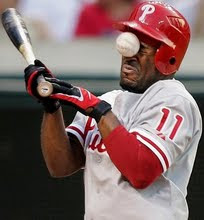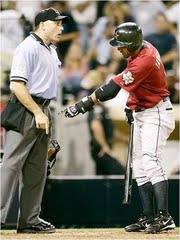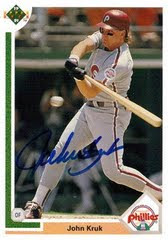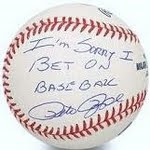 Let's begin by determining Granderson's 2009 xBABIP. Granderson hit .249/.327/.453 with a .276 BABIP. THT's xBABIP calculator (screenshot to the right) puts Granderson's 2009 xBABIP at .301. Granderson's career BABIP is .323, but his speed score has been down each of the last two seasons and almost half of his hits were flyballs last year (xBABIP for flyballs is .138). Thus a .301 xBABIP makes sense, despite the 21.2 LD%.
Let's begin by determining Granderson's 2009 xBABIP. Granderson hit .249/.327/.453 with a .276 BABIP. THT's xBABIP calculator (screenshot to the right) puts Granderson's 2009 xBABIP at .301. Granderson's career BABIP is .323, but his speed score has been down each of the last two seasons and almost half of his hits were flyballs last year (xBABIP for flyballs is .138). Thus a .301 xBABIP makes sense, despite the 21.2 LD%.Now that we have an xBABIP to work with, we need to adjust Granderson's 2009 numbers to eliminate the bad luck he experienced last year. BABIP is calculated by the formula: (H-HR)/(AB-K-HR+SF). With HR totals present in the formula and a goal of neutralizing luck, it is important to determine whether or not it is necessary to modify Granderson's 2009 baseline HR total. According to Hit Tracker Online (HTO), Granderson had two "lucky home runs. HTO does not account for "just missed" home runs, but I think its a safe to assume that Granderson was "robbed" at least once (or that he "just missed" a home run or two in a cavernous park) last season. Therefore, I am not going to modify Granderson's baseline home run total. Using a .301 xBABIP and 30 HRs as the basis for normalizing Granderson's 2009 line in Comerica park, we find that Granderson's expected hit total from 2009 (xHits) playing for the  Tigers would rise from 157 to approximately 169 [xHits=0.301*(631-141-39+2)+39]. It is difficult to say, at least with any semblance of accuracy, which of these additional 12 hits would have been singles, doubles or triples, so I am simply going to assume that they are all singles in determining Granderson's luck-neutralized 2009 triple slash line. Using Granderson's 72 walks, 2 HBP and +12 singles, Granderson's 2009 luck-neutralized triple slash line playing for the Tigers would be .268/.353/.486 (.839 xOPS vs his actual .780 OPS).
Tigers would rise from 157 to approximately 169 [xHits=0.301*(631-141-39+2)+39]. It is difficult to say, at least with any semblance of accuracy, which of these additional 12 hits would have been singles, doubles or triples, so I am simply going to assume that they are all singles in determining Granderson's luck-neutralized 2009 triple slash line. Using Granderson's 72 walks, 2 HBP and +12 singles, Granderson's 2009 luck-neutralized triple slash line playing for the Tigers would be .268/.353/.486 (.839 xOPS vs his actual .780 OPS).
Using ESPN's park factor adjustments, we can now convert Granderson's luck-neutral line at Comerica into a luck-neutral line at New Yankee Stadium. First, lets start with the home run totals. According to ESPN's park factor data, Comerica Park depressed home runs by 3.6%, while Yankee Stadium inflated them by 26.1%. Taking Curtis Granderson's 30 home run total at Comerica as the baseline, Granderson's xHR total at New Yankee Stadium would be approximately 39. Accordingly, Granderson's xHit total at New Yankee Stadium would rise to 175. These additional six hits would come at the expense of three doubles and four triples. Thus, Granderson would gain nine homers and four singles by moving to New Yankee Stadium. According to ESPN's park factor data, Granderson would also gain five walks from his change of scenery. Thus, Curtis Granderson's luck-neutralized 2009 line, if he played for the Yankees rather than the Tigers last season, would have been .277/.364/.522 (.886 OPS).
By contrast, Johnny Damon, eight years Granderson's senior, hit .282/.365/.489 (.854 OPS) with 24 homers. It is also worth noting three additional points. First, Damon's UZR/150 last season was -12.1 in LF, while Granderon's posted a +1.6 UZR/150 in CF. Second, Johnny Damon has not once played in even 150 games since 2004. Granderson, by contrast, has played in 155+ games in three of his four major league seasons (he played in 141 games during his injured 2008 season). Finally, Curtis Granderson is owed $25.75 million through 2012 (including a $2 million buy out for 2013), while he can be had for an additional $11 million in 2013. On the other hand, Johnny Damon was paid $13 million last year and is looking for his last lucrative major league contract before he is too old to command a contract of both satisfactory length and pay. Even if Damon was willing to take a pay cut to come back to the Yankees for three years, $30 million, Granderson is the better, younger, and cheaper player.
games in three of his four major league seasons (he played in 141 games during his injured 2008 season). Finally, Curtis Granderson is owed $25.75 million through 2012 (including a $2 million buy out for 2013), while he can be had for an additional $11 million in 2013. On the other hand, Johnny Damon was paid $13 million last year and is looking for his last lucrative major league contract before he is too old to command a contract of both satisfactory length and pay. Even if Damon was willing to take a pay cut to come back to the Yankees for three years, $30 million, Granderson is the better, younger, and cheaper player.
The Yankees made out big in this trade. They upgraded their 25 man roster by trading a high-potential starting pitcher with no room on the major league roster and a highly fungible reliever for one of the game's best value OFs. In addition, they gained a lot of negotiating leverage in the free agency market because they know that they can stand pat with who they have now (having re-signed Pettite earlier today) and be at least as competitive as they were in 2009 (especially with a healthy A-Rod). The Yankees are primed to repeat as not only the best team in the NL East, but the AL. I would not be surprised to see them in the World Series again in 2010. And the scary part? They will still have payroll room (compared to 2008 and 2009) to add any necessary pieces at the trade deadline.
Alas, I digress. Returning to the forecasting front, Granderson's luck-neutral 2009 numbers translate into a .277/.364/.522 (.886 OPS) triple slash line if he were a Yankee last year. Granderson would have, in theory, drawn 77 walks, hit 20 doubles, 4 triples, 39 homers and 112 singles. Below are Curtis Granderson's home run scatterplot charts from 2007-2009 (click to enlarge).
As you can tell from the above data, 60 of Granderson's previous 73 home runs went to right field. Given New Yankee Stadium's cozy right-field porch (same with Fenway), Granderson seems almost a lock for 35+ home runs next season despite his two-year decline in ISO. Why? If for no other reason than the fact that Granderson's ISO at home (.190) is a full 42 points lower than it is away from Comerica Park (.232). Furthermore, Curtis Granderson turns 29 next year. He is in his prime and it's not unreasonable to expect him to maintain his +.200 ISO ways for the duration of his current contract (through his 32 age year, if the Yankees pick up his 2013 option). With a 30-35+ home run and double digit (closer to twenty) stolen base expectations and a reasonable BA rebound to the .275 range, Curtis Granderson should be a top 10 OF next season. Put in the right part of the order, Granderson will also have 100 R/100 RBI potential. Rather than waste top dollar on great, but overvalued commodities like Kemp, Ellsbury and Braun next season, why not take a look at Granderson? I promise you won't be disappointed.
 Tigers would rise from 157 to approximately 169 [xHits=0.301*(631-141-39+2)+39]. It is difficult to say, at least with any semblance of accuracy, which of these additional 12 hits would have been singles, doubles or triples, so I am simply going to assume that they are all singles in determining Granderson's luck-neutralized 2009 triple slash line. Using Granderson's 72 walks, 2 HBP and +12 singles, Granderson's 2009 luck-neutralized triple slash line playing for the Tigers would be .268/.353/.486 (.839 xOPS vs his actual .780 OPS).
Tigers would rise from 157 to approximately 169 [xHits=0.301*(631-141-39+2)+39]. It is difficult to say, at least with any semblance of accuracy, which of these additional 12 hits would have been singles, doubles or triples, so I am simply going to assume that they are all singles in determining Granderson's luck-neutralized 2009 triple slash line. Using Granderson's 72 walks, 2 HBP and +12 singles, Granderson's 2009 luck-neutralized triple slash line playing for the Tigers would be .268/.353/.486 (.839 xOPS vs his actual .780 OPS).Using ESPN's park factor adjustments, we can now convert Granderson's luck-neutral line at Comerica into a luck-neutral line at New Yankee Stadium. First, lets start with the home run totals. According to ESPN's park factor data, Comerica Park depressed home runs by 3.6%, while Yankee Stadium inflated them by 26.1%. Taking Curtis Granderson's 30 home run total at Comerica as the baseline, Granderson's xHR total at New Yankee Stadium would be approximately 39. Accordingly, Granderson's xHit total at New Yankee Stadium would rise to 175. These additional six hits would come at the expense of three doubles and four triples. Thus, Granderson would gain nine homers and four singles by moving to New Yankee Stadium. According to ESPN's park factor data, Granderson would also gain five walks from his change of scenery. Thus, Curtis Granderson's luck-neutralized 2009 line, if he played for the Yankees rather than the Tigers last season, would have been .277/.364/.522 (.886 OPS).
By contrast, Johnny Damon, eight years Granderson's senior, hit .282/.365/.489 (.854 OPS) with 24 homers. It is also worth noting three additional points. First, Damon's UZR/150 last season was -12.1 in LF, while Granderon's posted a +1.6 UZR/150 in CF. Second, Johnny Damon has not once played in even 150 games since 2004. Granderson, by contrast, has played in 155+
 games in three of his four major league seasons (he played in 141 games during his injured 2008 season). Finally, Curtis Granderson is owed $25.75 million through 2012 (including a $2 million buy out for 2013), while he can be had for an additional $11 million in 2013. On the other hand, Johnny Damon was paid $13 million last year and is looking for his last lucrative major league contract before he is too old to command a contract of both satisfactory length and pay. Even if Damon was willing to take a pay cut to come back to the Yankees for three years, $30 million, Granderson is the better, younger, and cheaper player.
games in three of his four major league seasons (he played in 141 games during his injured 2008 season). Finally, Curtis Granderson is owed $25.75 million through 2012 (including a $2 million buy out for 2013), while he can be had for an additional $11 million in 2013. On the other hand, Johnny Damon was paid $13 million last year and is looking for his last lucrative major league contract before he is too old to command a contract of both satisfactory length and pay. Even if Damon was willing to take a pay cut to come back to the Yankees for three years, $30 million, Granderson is the better, younger, and cheaper player.The Yankees made out big in this trade. They upgraded their 25 man roster by trading a high-potential starting pitcher with no room on the major league roster and a highly fungible reliever for one of the game's best value OFs. In addition, they gained a lot of negotiating leverage in the free agency market because they know that they can stand pat with who they have now (having re-signed Pettite earlier today) and be at least as competitive as they were in 2009 (especially with a healthy A-Rod). The Yankees are primed to repeat as not only the best team in the NL East, but the AL. I would not be surprised to see them in the World Series again in 2010. And the scary part? They will still have payroll room (compared to 2008 and 2009) to add any necessary pieces at the trade deadline.
Alas, I digress. Returning to the forecasting front, Granderson's luck-neutral 2009 numbers translate into a .277/.364/.522 (.886 OPS) triple slash line if he were a Yankee last year. Granderson would have, in theory, drawn 77 walks, hit 20 doubles, 4 triples, 39 homers and 112 singles. Below are Curtis Granderson's home run scatterplot charts from 2007-2009 (click to enlarge).
As you can tell from the above data, 60 of Granderson's previous 73 home runs went to right field. Given New Yankee Stadium's cozy right-field porch (same with Fenway), Granderson seems almost a lock for 35+ home runs next season despite his two-year decline in ISO. Why? If for no other reason than the fact that Granderson's ISO at home (.190) is a full 42 points lower than it is away from Comerica Park (.232). Furthermore, Curtis Granderson turns 29 next year. He is in his prime and it's not unreasonable to expect him to maintain his +.200 ISO ways for the duration of his current contract (through his 32 age year, if the Yankees pick up his 2013 option). With a 30-35+ home run and double digit (closer to twenty) stolen base expectations and a reasonable BA rebound to the .275 range, Curtis Granderson should be a top 10 OF next season. Put in the right part of the order, Granderson will also have 100 R/100 RBI potential. Rather than waste top dollar on great, but overvalued commodities like Kemp, Ellsbury and Braun next season, why not take a look at Granderson? I promise you won't be disappointed.










8 comments:
"Taking Curtis Granderson's 30 home run total at Comerica as the baseline, Granderson's xHR total at New Yankee Stadium would be approximately 39"
Isn't this assuming that Granderson played all of his games in 2009 at Comerica?
You are correct Anonymous. It is a very rough forecast, but players play 1/2 of their games come at home. To get the most "accurate" forecast, i would have to adjust his numbers based on his playing time at each and every park and I do not have the time/patience to look at the Yankees scheduele and weight my H/2B/3B/HR/BB projections based on playing time per park and each park's factors.
Perhaps I will put a disclaimer in the intro. That is also why I projected 30-35+ HRs for granderson next season, not 40+. FURTHERMORE, the Yankees play a lot of games at Fenway, which also distorts offense a lot as well, so between the 92 games at Fenway/Yankee Stadium next year, I am comfortable with my rough estimates.
Thanks for the response. I really liked the article and look forward to big things from Granderson in the next few years.
no, no. Thank you. We always appreciate the feedback. Glad you enjoyed the article.
I agree with your overall conclusion about Granderson's increased value for 2010, and your analysis is good for the most part, but a couple of your premises are flawed. First of all, you can't ignore the fact that half of the games are played on the road. To make a "rough forecast" you can simply assume the road games are played in parks that average out to an approximately league average park. So all you have to do is cut the home park factors in half to determine how much to adjust to overall season numbers.
Also, not that it means that much to Granderson, but Fenway Park absolutely is not a good home run park for lefties. In right field, Fenway is only short directly down the line. The rest of right field is deeper than the average park. According to HitTracker, only 5 home runs were hit down Fenway's right field line in 2009 that traveled less than 340 feet. Those 5 homers were the only ones all season that were aided by Fenway's short porch down the line because the rest of the home runs in that direction would have gone out of more than half of major league parks, according to HitTracker analysis. Overall, over the past three seasons Fenway has been the third worst park in the AL for home runs by lefthanded batters, suppressing them by 15%, according to the Bill James Handbook. This would be relevant to Granderson if he was headed to the Red Sox, but as I said you can simply assume road games are played in parks that are cumulatively close to league average.
The Bill James Handbook shows Comerica suppressing lefthanded home runs by 4% over the last three seasons, and New Yankee Stadium inflating lefty homers by 20% (obviously only one year of data). Cutting these numbers in half to account for road games would result in Granderson's 30 HR in 2009 with the Tigers translating to 34 HR with the Yankees. However, park factors are not necessarily indicative of how a particular player's numbers will be affected there, and I wouldn't be surprised if Granderson is helped even more than that by Yankee Stadium because he is such a dramatic flyball/pull hitter.
Seth ---
You raise a great point. In the future, I should probably weight the numbers by park factor in half so as to better account for a rough forecast. Going forward with a model macro set i made in Excel, I will use this adjustment.
I did not actually realize that Fenway was so poor for Lefty homers. I really should get the bill james handbook. Does it give park index adjustments?
It is also important to note that the data for New Yankee Stadium is one year old and it will take 3 years worth of data to get more accurate forecasts based on the park factors
Yes, The Bill James Handbook has park index adjustments for R, AVG, 2B, 3B, HR, BB, SO, and even Errors. It further breaks down the AVG and HR park indices by lefthanded and righthanded batters.
Believe it or not, even with the Green Monster in left, Fenway is also a below average HR park for righties. I think most people think Fenway inflates home runs, but the overall HR park index is only 91 over the last three years, fourth lowest in the AL. Fenway does significantly inflate offense, but not because of home runs. It has the highest three-year park indices in the AL for Runs (111), AVG (107), and Doubles (145!). Batting average is increased by the left field wall along with the small amount of foul territory, and doubles are dramatically increased by the left field wall.
I agree with you about the unreliability of New Yankee Stadium's one-year park factors. For example, the righthanded HR index was actually larger (133) than the lefthanded HR index (120). I would expect this will end up being a fluke, since right field is significantly shorter than left field. The righthanded HR index could have been somewhat affected by the fact that Jeter hit so many of his homers to right field in Yankee Stadium, and was therefore not exactly indicative of how the park would play for a typical righthanded batter.
we have to take into a acount many points to do a analyzis like this, the season wasn't that I want, but what I can do?
Post a Comment